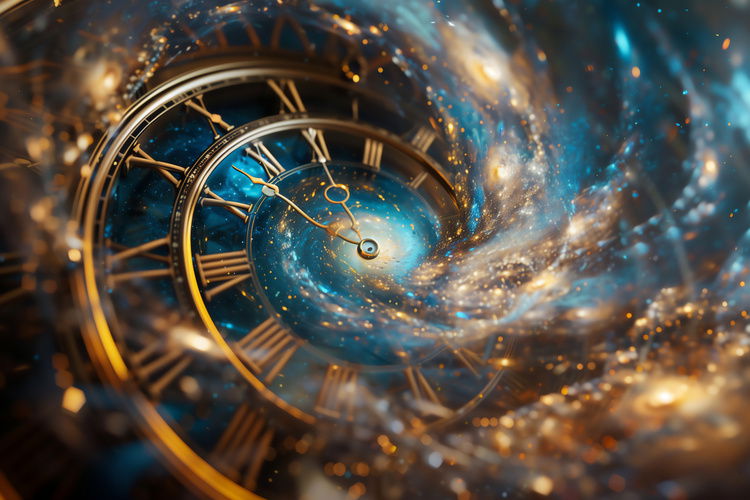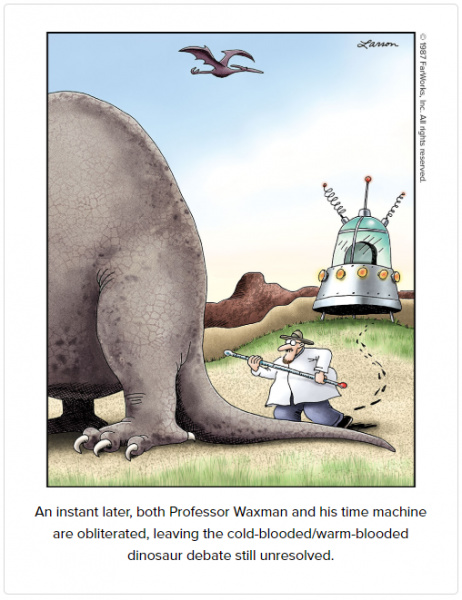
Posted on 01/14/2025 11:01:23 AM PST by Red Badger

Time travel has long captured the human imagination, from its appearances in science fiction fantasies to its profound implications in modern theoretical physics. Now, a recent study by Dr. Lorenzo Gavassino, a theoretical and mathematical physicist at Vanderbilt University, delves into the enigmatic nature of time travel involving time loops to examine their profound implications for quantum mechanics, entropy, and human experience.
Dr. Gavassino’s findings, published in Classical and Quantum Gravity, present a strikingly different picture of time travel. They reveal that traveling through such time loops would prevent many classical time travel paradoxes, including the infamous “grandfather paradox.”
“It is often assumed that, in a Universe with Closed Timelike Curves (CTCs), people can ‘travel to the past,'” Dr. Gavassino writes. “On the surface, this seems to be an obvious implication, since (on sufficiently large scales) one may view a timelike curve as the worldline of a hypothetical spaceship traveling across the spacetime. However, to confirm that this is an actual journey to the past, we must first discuss what happens to the passengers (i.e., to macroscopic systems of particles) as they complete the roundtrip.”
“For example, consider the following question: ‘Can Alice meet her younger self at the end of the journey?’ Answering this and similar queries ultimately boils down to determining the statistical evolution of non-equilibrium thermodynamic systems on CTCs.”
Einstein’s theory of general relativity proposes that time travel to the past might be theoretically possible under specific conditions, such as exotic spacetime geometries like traversable wormholes, cosmic strings, or faster-than-light travel.
However, even if such phenomena were achievable, scholars have long grappled with the logical contradictions time travel introduces. In particular, the paradoxes associated with foreknowledge of the future render time travel implausible.
The consistency paradox is often considered the cornerstone of these time travel conundrums, which asks what happens if a time traveler alters the past in ways that prevent their existence.
Commonly known as the “grandfather paradox,” the consistency paradox has been a staple of science fiction, frequently explored in stories about time travel. For example, in the 1985 film Back to the Future, the main character, Marty McFly, accidentally creates a paradox that prevents his parents from meeting, jeopardizing his own existence.
In his recent paper, Dr. Gavassino offers a provocative solution to time travel’s biggest logical challenges. According to him, in a universe with closed timelike curves (CTCs), the laws of quantum mechanics would inherently erase many time travel paradoxes.
Dr. Gavassino’s study reveals that any system traveling through a time loop experiences a reset in entropy and memory, ensuring that causality remains intact and preventing contradictions like the grandfather paradox from arising.
At the core of Dr. Gavassino’s research lies the concept of closed timelike curves (CTCs), theoretical paths within spacetime that loop back to their origin.
Closed timelike curves could only exist under highly exotic conditions predicted by Einstein’s general relativity. These conditions include phenomena such as traversable wormholes, where a stable tunnel between distant points in spacetime is maintained using negative energy or exotic matter to prevent collapse.
Similarly, rotating spacetimes, like those described by the Gödel metric, suggest that intense angular momentum on a cosmic scale could create paths that loop back in time.
Cosmic strings, hypothesized one-dimensional defects formed during the early universe, could also theoretically generate CTCs if they moved past each other at near-light speeds or rotated rapidly, distorting spacetime enough to permit time loops.
Another possibility involves Kerr black holes, where the extreme rotation near their event horizons could theoretically enable closed paths in time, though such regions are likely unstable due to singularities and quantum effects.
These scenarios require conditions far beyond what is naturally observable or technologically achievable, including negative energy density or exotic spacetime geometries. Likewise, these theoretical constructs face significant challenges, such as energy requirements, stability issues, and the potential invalidation of causality, making the natural or artificial creation of CTCs an extraordinary challenge.
Nevertheless, Dr. Gavassino used a mathematical model of a spaceship traveling on a CTC to examine such a journey’s physical and quantum dynamics. His analysis revealed that systems traveling along these curves undergo a spontaneous quantum restructuring, including discrete energy level adjustments and entropy inversions. This ensures that all internal states and systems reset to their original configuration by the end of the loop.
One of the study’s most remarkable discoveries is the erasure of memories for individuals or systems traveling on a CTC. Memory formation, closely tied to the increase of entropy over time, is inherently unstable on a CTC due to the reversal of the entropic arrow of time.
As entropy decreases during the journey’s second half, all processes—including memory retention—reverse, leaving the traveler unable to recall their experiences within the loop.
This phenomenon ensures that no observer within the loop can interfere with their past or create causal paradoxes, as their memory and internal states are effectively “reset” upon completing the journey.
In simple terms, time travel may be theoretically possible, but Dr. Gavassino’s findings reveal that altering the past is fundamentally impossible.
Entropy plays a pivotal role in understanding the physics of time loops. In ordinary systems, entropy—the measure of disorder—steadily increases, providing a clear arrow of time.
However, Dr. Gavassino’s findings show that CTCs impose a periodic constraint on entropy, requiring it to return to its minimum value at specific points along the loop.
This phenomenon aligns with the Poincaré recurrence theorem, which predicts that finite, isolated systems will eventually return to their initial states. In the case of CTCs, this return occurs at regular intervals, dictated by the curve’s properties.
Dr. Gavassino’s research demonstrates how quantum mechanics ensures the self-consistency of time loops. The study shows that the energy levels of systems traveling on CTCs are quantized so that all processes remain coherent and self-correcting.
For example, an unstable particle that decays into smaller components during the journey is observed to spontaneously reassemble into its original form as the journey nears its end. While counterintuitive in ordinary thermodynamics, this behavior is a natural consequence of the quantum constraints imposed by the CTC.
The implications of these findings could be profound. Unlike the chaotic and paradoxical time travel scenarios often depicted in science fiction, the findings suggest that time travel via CTCs operates under strict quantum mechanical rules that prevent disruptions to causality. Any deviations in entropy are reversed, memories are erased, and the system returns to its starting state without contradictions or inconsistencies.
This framework provides a stable, albeit unsettling, model of time travel in which classical paradoxes such as meeting a younger version of oneself or altering the past are inherently avoided.
The study also delves into the nature of reality within a time loop. At the point of minimum entropy on a CTC, causality appears to break down entirely. Complex systems, including living organisms, can seemingly “fluctuate into existence” without a clear origin, consistent with quantum statistical mechanics.
For example, a book might appear without an author, or a person might possess memories that have no logical basis in the system’s macroscopic history. These low-entropy states exist in isolation, disconnected from traditional causal chains, yet they fit within the broader framework of quantum mechanics.
While the study does not claim that interacting with one’s future or past self is impossible, it frames such encounters unconventionally. Any older version of a person encountered in a time loop would likely have no causal relationship to the younger version due to the resetting of entropy and memory. Such an “older clone” might emerge from the random fluctuations at the loop’s minimum entropy point, carrying no verifiable link to the timeline of the younger self.
Dr. Gavassino’s work offers a unique perspective on time travel, grounding these speculative ideas in the rigorous framework of quantum mechanics.
While closed timelike curves remain purely theoretical, their implications challenge and expand our understanding of time, causality, and the laws of the universe.
This research highlights that if time travel were ever possible, it would not resemble the whimsical journeys of popular culture but instead operate as a highly constrained and self-consistent quantum process.
Ultimately, while the possibility of traversing through time may not be as far-fetched as once thought, one crucial takeaway is clear: the past is permanent.
No matter how advanced our understanding of spacetime becomes, the laws of physics appear to safeguard causality, ensuring that history remains unchangeable. Time travel may one day allow us to observe and experience the past—but rewriting it will forever remain out of reach.
Right now He’s seeing me being born while He’s also seeing when I’ll die while He’s also seeing me in the here and now.
God tells us “I AM”, not will be or was..............
I will get my own aspirin.
There was a game, US Patent No. 1, about time machine inventors fighting to get the first patent on the day the patent office opened.
Plain language? Impossible! Plain language wasn’t built for time travel! Unless you want to talk about what will’ve’d’ed is’ded’ve’d beened’veded.
If I could travel back in time, I’d go back to February 15, 1971 with 60 RU-486 pills. I’d go to d’Ottawa and feed Margaret Trudeau one pill a day, from February 15 through April 16.
No idea what I just read
But it made me sleepy.
Imagine right after you invent your time machine you get a note from yourself telling you must use your new time machine to kill an Australian baby you’ve never heard of. So you go to Melbourne in 1889 and destroy world history because of your bad handwriting.
The Grandfather Paradox is solved by reading and understanding 1 Samuel 23 and quantum physics.
If you went back in time, you would be interacting with the matter there but it wouldn’t be YOUR grandfather you were interacting with. It would simply be a person in the other timeline which you created by interacting with the matter in it.
Similarly, David gets killed by Saul in Keilah and also he doesn’t get killed by Saul in Keliah. We are in the second timeline.
You shouldn't do that even if you could. It's wrong to kill a child. BUT . . . if you wait until he's a teenager . . well that's a different story.

That’s how I think it is. Another way to visualize it is get a blank piece of paper. Put a dot on it. That is the universe. From the dot draw a line for a few inches. That is the universe through time from beginning to end. God is the paper itself completely underpinning the universe and surrounding it throughout time.

Sci-Fi plotlines will become infinitely more boring under this constraint.
Maybe this can account for the bright light people report in near death experiences.
I wonder what happens to the numbers if hyper-luminal travel, via exotic propulsion or hyper-space shortcut, induces a negative time dialation effect.
IOW... If your reference time at point of origin is where the Universal clock is based off of. At Sub-C or C speeds, time dialation means that your experienced time becomes subjective and real space/time clicks along at a different pace.
This is where the usual tropes of 2 year subjective becomes hundreds of years for those you left behind.
But now consider hyper-luminal... where that time debt is no longer subjective. Your 6 month trip out, 6 months on-site, and 6 months back at n+C speeds means you come back and only 18 months have passed. The difference in n+C would then only effect how much volume you’ve traversed.
So if you save Lincoln, then Lincoln has still been shot in your universe, but you've created a new universe in which Lincoln has not been shot.
Something to do with string theory, I think.
It is just how our informational reference frame, Reality, moves through it that creates our perception of what is Real.
Information cannot be destroyed. Even Hawking needed to back off that a bit due to the evaporation of “black holes”...
Everything you've ever done lives on frozen in time. Everything you could possibly do is already written in to the future. Just because you take one path, doesn't mean the rest cease to exist...
My I-Ching calculator says, “suffusion of yellow”... /Douglas Adams
Well, I don’t know what is really real, but I’m an NPC. Just wanted to share that. Or did I?
Sending mass into the past adds mass, and energy, to the universe in the past, which adds mass to the present out of nowhere. Can’t be done.
The biggest problem with time travel is that one cannot go to a place that doesn’t exist... like the past... or the future.
_________________________
Have you considered that time and space may not exist?
Disclaimer: Opinions posted on Free Republic are those of the individual posters and do not necessarily represent the opinion of Free Republic or its management. All materials posted herein are protected by copyright law and the exemption for fair use of copyrighted works.